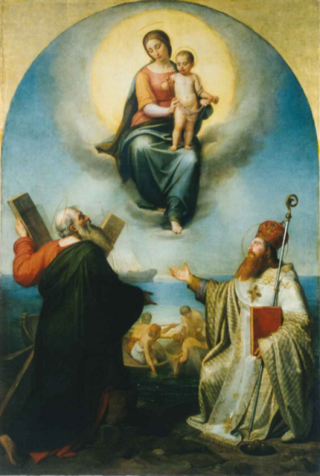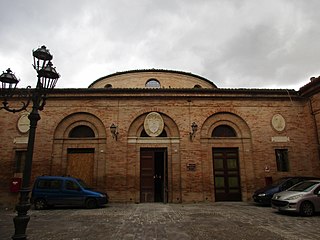
Macerata is a city and comune in central Italy, the county seat of the province of Macerata in the Marche region. It has a population of about 41,564.

Castro Pretorio is the 18th rione of Rome (Italy), identified by the initials R. XVIII, and it is located within the Municipio I. The rione takes its name by the ruins of the Castrum Praetorium, the barracks of the Praetorian Guard, included in the Aurelian Walls.
The music of the Marche, a region of Italy, has been shaped by the fact that the entire region is a collection of small centers of population. There is no cultural giant to be found—no Florence or Naples—that might have shaped the cultural and musical expressions of the entire region. There is not a town in the region with more than 100,000 population, but there are 246 total towns, and they support no fewer than 113 theaters, a cultural building boom that started in the late 18th century. Historically, the entire area was home to a great number of monasteries and abbeys in the Middle Ages, institutions that had choirs and were active in the musical lives of the inhabitants. That period is still obscure and is currently the subject of musicological research. In the modern age, the region has a vibrant musical life.
Theatres for diverse musical and dramatic presentations began to open in Naples, Italy, in the mid-16th century as part of the general Spanish cultural and political expansion into the kingdom of Naples, which had just become a vicerealm of Spain. None of the early theaters still function as such, having been replaced by later facilities from the mid-18th century onwards. Neapolitan theatres first built in the 16th and 17th centuries include:

The Sacred Mountain of Varallo is a Sacro Monte overlooking the town of Varallo Sesia in the province of Vercelli, Piedmont, northern Italy. It is the oldest Sacro Monte, founded in 1491 by Franciscan friar Bernardino Caimi. It is built on a natural terrace on the rocky slopes of Monte Tre Croci, on the left bank of the Sesia river where it leaves Val Mastallone. It is 600 m above sea level, 150 m above the historic centre of Varallo.

Cosimo Morelli was an Italian architect, active throughout the Papal States in a Neoclassic style.

The Opera dei Pupi is a marionette theatrical representation of Frankish romantic poems traditionally performed in Sicily, Italy.
Matteo Tassi was an Italian painter, best known for his decorative frescoes and restorations.

The Arch of Augustus in Fano is a city gate in the form of a triumphal arch with three vaults. It is the entrance to the city by the via Flaminia, which became the inside of the wall of the decumanus maximus. It is one of the symbols of the city.
Giuseppe Lucatelli (1751-1828) was an Italian painter and architect, active in a Neoclassical style.

The Teatro Flavio Vespasiano is the main theatre and opera house in Rieti. It was opened on 20 September 1983, after ten years of work and finishing touches; directed by architect Achille Sfondrini. It takes its name from the Roman emperor Titus Flavius Vespasian who was born in sabina.

The Ventidio Basso Theater is the communal theater, concert hall, and opera house in the city of Ascoli Piceno region of Marche, Italy. It is located on via del Trivio, in front main cloister of the church of San Francesco, near piazza del Popolo. The exterior was erected in neoclassical-style, with grand interiors.
Cassa di Risparmio di Fermo S.p.A. (Carifermo) is an Italian savings bank based in Fermo, Marche region.

Luigi Cochetti was an Italian painter.

The Basilica di San Francesco is a Gothic-style, Roman Catholic church located on the Piazza del Popolo in the town of Ascoli Piceno in the region of Marche, Italy.
The Chiesa della Madonna della Misericordia is a Roman Catholic church located on Piazza San Martino in the town of Petriolo, province of Macerata, region of Marche, Italy. It stands facing both the Palazzo Communale and the church of Santi Martino e Marco.

The Teatro Vaccaj or Vaccai is a historic opera house in Tolentino, Italy.

The Teatro della Fortuna is a music and theater venue in Fano, province of Pesaro and Urbino, region of Marche, Italy.
Savino Monelli was an Italian tenor prominent in the opera houses of Italy from 1806 until 1830. Amongst the numerous roles he created in world premieres were Giannetto in Rossini's La gazza ladra, Enrico in Donizetti's L'ajo nell'imbarazzo and Nadir in Pacini's La schiava in Bagdad. He was born in Fermo where he initially studied music. After leaving the stage, he retired to Fermo and died there five years later at the age of 52.












